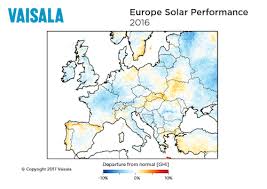Dependable Data is the New Solar Subsidy - Vaisala
As the first FiT-free projects come online in Europe, reliable site data will break reliance on subsidies and be the difference between profitability and underperformance
VAISALA CORPORATION - PRESS RELEASE
JULY 5, 2017
As feed-in tariff (FiT) support is phased out in the key European solar markets, developers, operators and investors must prioritize investment in robust methods of long-term data collection and analysis. With the first subsidy-free projects now entering operation, project stakeholders can no longer rely on tariff support to provide revenue stability and must focus on the reliability of their site data to mitigate the impact of irradiance fluctuations on financial performance.
This is the assessment of Vaisala, a global leader in environmental and industrial measurement, and is supported by its 2016 Europe Solar Performance Maps, released today. These maps illustrate substantial long-term irradiance variation, spanning core markets including Italy, France, Spain and the U.K.

"The irradiance variations we have measured in 2016 are very much in line with what the industry has come to expect over the past 10 years of operation," said Gwendalyn Bender, Head of Solar Service, Vaisala. "What they do show, however, is that developing and operating low and zero-subsidy plants is going to require careful planning of how assets are managed. In response, European asset owners need to start thinking very seriously about how they collect and use site data to gain more insight into operations and management."
With increasing independence comes increasing vulnerability
Rapidly falling costs throughout the global solar PV supply chain, rising demand for new installations and increasing manufacturing capacity have facilitated project financing and afforded the sector growing independence from government support mechanisms. This changing risk landscape has seen several unsubsidized projects installed in Italy and Spain, and similar progress is being made in the U.K. and Germany.
However, transitioning to subsidy-free development and operations introduces challenges for a sector that has thus far relied on government tariffs to ensure it meets its long-term financial commitments to investors. If this transition is not properly managed, with a sound understanding of the link between available resource and asset performance, asset owners and investors exposed to the risks of fluctuating performance could face serious losses.
Under- and over-performance challenges
For an unsubsidized solar PV project, any substantial long-term deviation from expected power production - whether below or above initial estimates - can negatively impact financial performance.
Vaisala estimates that a 2% shortfall from expected irradiance over a 12-month period can cost approximately €1 million in lost revenues for the owner of a 300MW portfolio of regional solar projects, which is fairly common in Europe. If the low anomaly occurs in spring or summer, when the project is expected to generate most of its income, the revenue hit can be particularly damaging, as the project is unlikely to make up the difference over the remainder of the year.
Simultaneously, if grid-connected projects consistently over-perform due to a prolonged period of above average solar irradiance, there is a risk that wholesale power prices will be depressed, impacting the ability of assets to deliver stable returns when performance reverts to normal. Over-performance also elevates the risk of curtailment during periods of peak power generation.
The scale of these potential challenges is underlined by Vaisala's 2016 solar performance maps, which show considerable swings in irradiance levels across mainland Europe - from close to 10% below average in Q1 to around 10% above average in Q3. Looking at the full 12 months of data, large swathes of the continent - including Italy, France and Germany - saw overall annual irradiance fall below long-term averages by approximately 2-3%.
Confidence in long-term financial performance
High levels of data confidence are required, both when producing project energy estimates at the financing and development stage, and when forecasting and optimizing energy production at operational sites to meet expectations. While long-term satellite irradiance data is providing an increasingly reliable means of informing financial decisions, investing in robust ground-based measurements is becoming more and more critical for the European sector.
Furthermore, the industry will need to use both long-term data and reliable on-site measurements to appropriately structure and implement the financial hedging and insurance mechanisms necessary to ensure revenue stability.
"Providing an appropriate investment is made into improving the quality of measurements, the market will find that resource data not only paves the way for a successful shift into the post-subsidy era, but also starts to fulfill the role played by tariffs in ensuring long-term financial performance," Bender concluded.
For further information, please contact:
Francesca Davidson
Energy Communications Expert, Vaisala
Tel +1 206 708 8544
francesca.davidson[at]vaisala.com
Vaisala Energy
Weather provides the fuel for renewable energy projects and is one of the largest variables impacting production. Vaisala uses more than 80 years of weather expertise to help the global renewable energy industry develop and operate wind and solar projects better, faster and more efficiently. Our measurement, assessment, forecasting and asset management products and services leverage proven science and advanced technology to mitigate the impact of weather risks on energy generation and support profitable decision-making across the entire project lifecycle, from greenfield prospecting and due diligence through operational forecasting and plant optimization. www.vaisala.com/energy twitter.com/VaisalaEnergy linkedin.com/company/vaisala-energy
About Vaisala
Vaisala is a global leader in environmental and industrial measurement. Building on 80 years of experience, Vaisala contributes to a better quality of life by providing a comprehensive range of innovative observation and measurement products and services for chosen weather-related and industrial markets. Headquartered in Finland, Vaisala employs approximately 1600 professionals worldwide and is listed on the NASDAQ OMX Helsinki stock exchange. www.vaisala.com www.twitter.com/VaisalaGroup